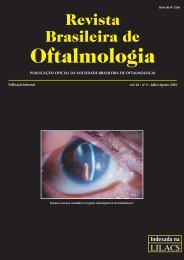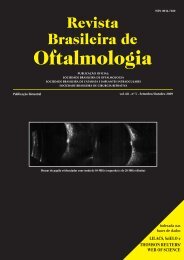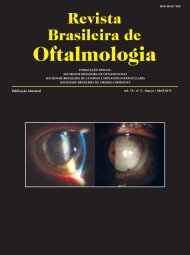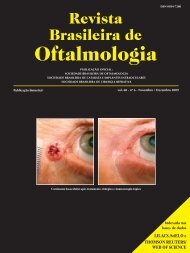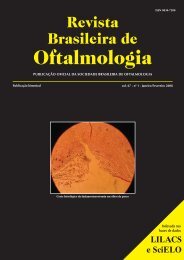Baixe aqui a versão em PDF da RBO - Sociedade Brasileira de ...
Baixe aqui a versão em PDF da RBO - Sociedade Brasileira de ...
Baixe aqui a versão em PDF da RBO - Sociedade Brasileira de ...
- No tags were found...
Create successful ePaper yourself
Turn your PDF publications into a flip-book with our unique Google optimized e-Paper software.
96Grandinetti AA, Dias J, Trautwein AC, Iskorostenski N, Moreira L, Moreira ATRINTRODUCTIONThe treatment of rhegmatogenous retinal <strong>de</strong>tachments andit complications continue to be one of the most importantindications for vitreoretinal surgery, being a well-knowncause of ocular refractive changes. The use of an encircling bandcreates an in<strong>de</strong>ntation of the eye that increases the anteroposterioraxial length and can change the corneal shape (1,2) . A myopicshift or lowering hypermetropia and irregular corneal astigmatismowing to the explants can be found (3) . More recently, withthe advent of small gauge transconjunctival vitrectomy, the effectsof the vitrectomy surgery on the cornea have been comparedwhen using different techniques (4) . Some studies haveevaluated corneal changes after pars plana vitrectomy andscleral buckling surgery, and although some studies found statisticallysignificant corneal shape changes (5,6) , others found no significantchanges (7) .Current techniques of rhegmatogenous retinal <strong>de</strong>tachmentrepair allow most <strong>de</strong>tachments to be repaired successfully. However,even after successful retinal reattachment, postoperativevision may be unsatisfactory for the patient in some cases due tosevere myopia or astigmatism that might persist after surgery (8) .The cornea’s refracting surface is responsible for about twothirds of the refractive power of the eye and plays an importantrole in focusing images on the retina. This function can be <strong>de</strong>finedin terms of corneal shape, regularity, clarity and the refractivein<strong>de</strong>x (5) , all of which might be susceptible to intraoperativecompromise after vitreoretinal surgery.In this study, we investigated the possible corneal changesafter 20-gauge pars plana vitrectomy (PPV) associated withscleral buckling for the treatment of rhegmatogenous retinal<strong>de</strong>tachment using computer-assisted vi<strong>de</strong>okeratography.METHODSTwenty-five patients with rhegmatogenous retinal <strong>de</strong>tachmentwho un<strong>de</strong>rwent 20-gaugePPV combined with scleral bucklingwere prospectively inclu<strong>de</strong>d in this study. Approval from theappropriate ethics committee was obtained, and informed consentwas acquired from all patients before surgery.Patients with a history of corneal changes prior to surgery (rigidcontact lens use, refractive surgery, cataract surgery, corneal trauma,corneal transplant, keratoconus, corneal ulcers) and other causes ofretinal <strong>de</strong>tachment (proliferative diabetic retinopathy, tractional, traumatic,associated with tumors of the choroid, and inflammation, amongothers) were exclu<strong>de</strong>d from the study. All surgeries were planne<strong>da</strong>nd performed by the same surgeon successfully (AAG).All patients un<strong>de</strong>rwent a 20-gauge PPV combined withscleral buckling, which consisted on the plac<strong>em</strong>ent of a infusioncannula 4 mm from the corneal limbus in the inferior t<strong>em</strong>poralquadrant between the insertions of the rectus muscles, and twosclerotomies 4mm from the corneal limbus in the upper quadrants,always located at the top of the line of the rectus muscles insertion.Total vitrectomy was performed, d<strong>em</strong>arcation of the tearswith endodiatermy, drainage of subretinal fluid followed byendolaser photocoagulation around the retinal tears. Scleral bucklingtechnique was performed using a silicone band number 42(Labtician S2971; Labtician Ophthalmic Inc, Cana<strong>da</strong>), which wassutured in the 4 quadrants at a distance of 11 mm from the corneallimbus, using Mersilene 5.0 sutures to hold the band in the middleof the quadrant. After the surgery was performed, the vitreouscavity substitute was chosen according to the discretion of thesurgeon (perfluoropropane gas or silicone oil) and the sclerotomiesand conjunctiva were closed using 7.0 vicryl sutures.Twenty-five eyes of these 25 patients were analyzed usingcomputerized vi<strong>de</strong>okeratography (EyeSys 2000; Corneal AnalysisSyst<strong>em</strong> v4.0). Corneal topography was measured before surgery,as well as one week, one month and three months aftersurgery. At least three vi<strong>de</strong>okeratographs were recor<strong>de</strong>d fromeach patient, and the <strong>da</strong>ta were obtained from the best qualitykeratograph. The analysis of the corneal vi<strong>de</strong>okeratographs wasbased on the Holla<strong>da</strong>y Diagnostic Summary (HDS) softwarepackage. The HDS gives four color-co<strong>de</strong>d maps and 15 cornealparameters. The maps inclu<strong>de</strong> two refractive power maps on stan<strong>da</strong>r<strong>da</strong>nd auto scales, a profile difference map for <strong>de</strong>terminingthe corneal shape, and a distortion map that provi<strong>de</strong>s informationabout the visual performance and optical quality of the cornea.The parameters from the HDS provi<strong>de</strong> information of thecentral 3mm of the cornea. It should be noted that optical distortionsoutsi<strong>de</strong> this 3.0mm pupil zone are shown to have little effecton the visual performance except when the pupil is dilated.In this study, steep refractive power, flat refractive power,and total astigmatism parameters from the HDS were used toinvestigate the changes in corneal topography. The steep refractivepower (K2) is the strongest refractive power in the centralcornea, whereas the flat refractive power (K1) is the weakestrefractive power. The difference between these two parametersis <strong>de</strong>fined as the total astigmatism of the cornea.RESULTSOf the twenty-five patients inclu<strong>de</strong>d in this study, 15 (60%)were male and 10 (40%) were f<strong>em</strong>ale. The left eye was affectedin 14 patients (56%) and the right eye in 11 patients (44%).The mean age ofthe patients admitted to surgeries was54.52 years, the youngest being 28-year-old and the ol<strong>de</strong>st 68-year-old.The assessment of the macula in the preoperative periodwas <strong>de</strong>fined as attached in 6 cases (24%) and <strong>de</strong>tached in 19cases (76%).The vitreous substitute most commonly used wasperfluoropropane gas (C3F8), in 19 patients (72%), and siliconeoil in 7 cases (28%).After surgery, an average of a 0,9 diopter (D) increase incentral corneal steepening, was <strong>de</strong>tected in the first week. Thedifference was statistically significant when compared with preoperativevalues (p



